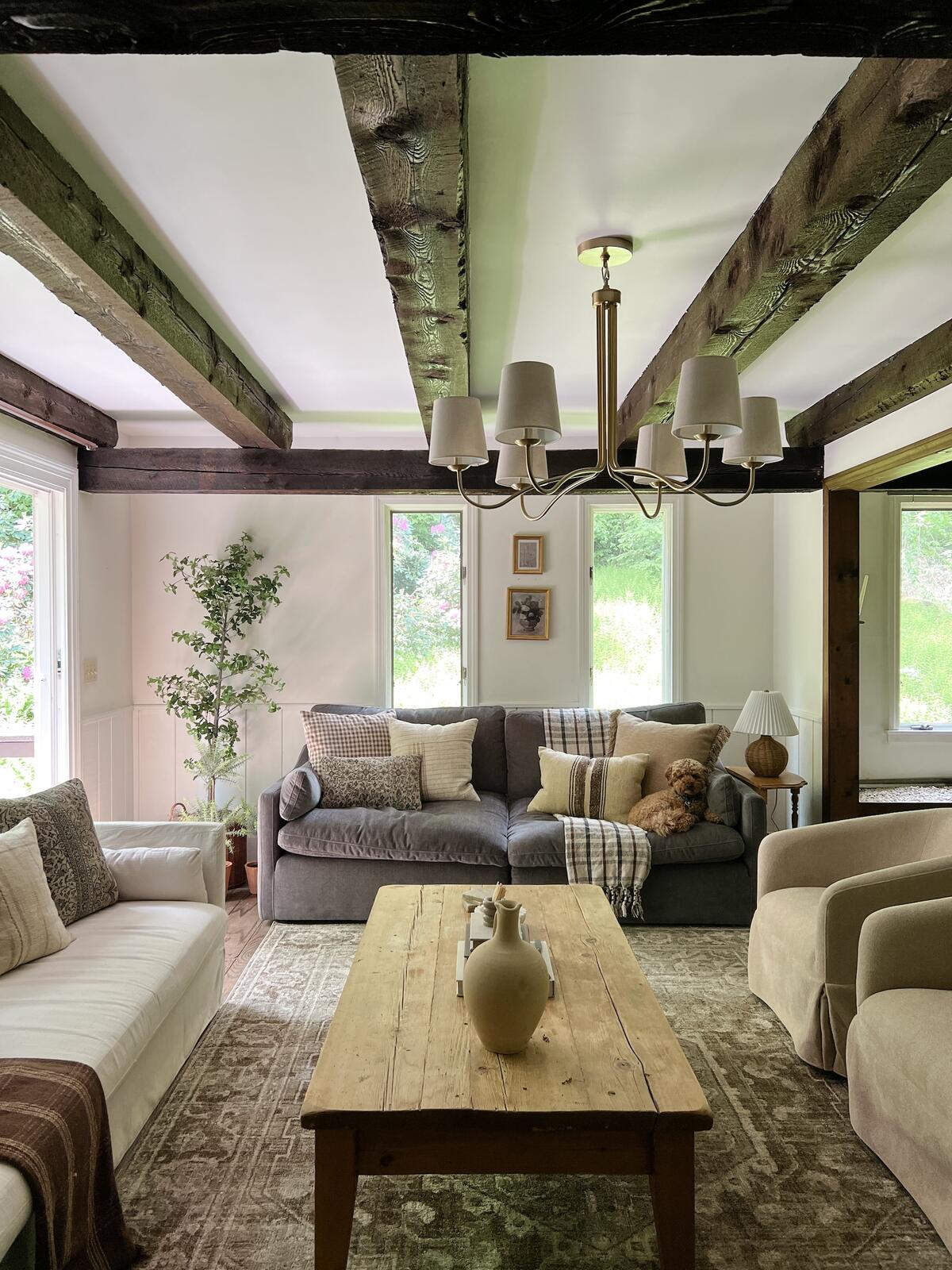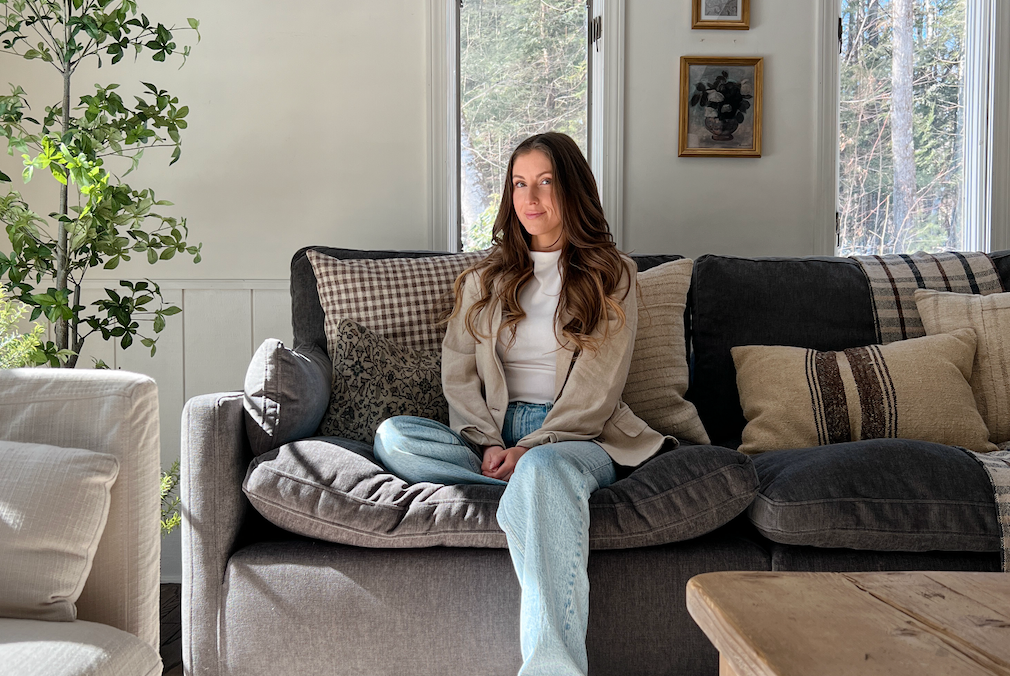In Ask an Influencer, Business of Home explores the creator economy. This week, we spoke with interior stylist and content creator Meghan Gallagher (@bymeghang).
During the early months of the pandemic, when salons across the country were required to close for an extended period of time, Meghan Gallagher’s 18-year career as a Philadelphia-based hairstylist came to a standstill. A creative through-and-through, she pivoted to another interest that had captured her attention since childhood: home design. “I tell people all the time that it feels like the same job mentally—my brain works the same way mapping out someone’s hair as mapping out someone’s room,” she says.
Gallagher had used social media casually in the past, and it was always the photos of her home projects and organizing techniques that seemed to make it past her immediate circle of friends and family. During the pandemic, her home projects revved up, and so did her social media posts—and before long, her following ballooned.

In response, she diversified her content, introducing closet organization tours, decor shopping vlogs and updates on her home renovation projects. Suddenly, followers wanted Gallagher to work her magic on their homes. Within a few months, she began taking on design clients and doing content creation full-time. A few years in, that hard work has paid off: Today, she has an audience totaling 115,000 followers on Instagram and over 155,000 on TikTok.
Ahead, the creative shares how she nails a brand partnership pitch, how she boosts engagement during a lull, and why she posts a mix of polished and casual videos for a well-rounded approach.
Landing brand partnerships
While Gallagher has experimented with different monetization strategies during her time as a content creator, brand partnerships have given her the steadiest form of income. As she works without an agent, most of the deals have come about organically: If she has already used a brand’s products, or has created a mood board with their products on it, she’ll plant the seeds over a period of time by commenting on the company’s posts and tagging them in her own content. Eventually, she’ll make a more direct connection by sending out DMs to let them know she’s interested in collaborating.
“I keep it short in the DMs. I usually start by just introducing myself—a sentence or two about me, who I am and what I do—and then I continue on with another sentence or two about what exactly it is I want to work with them on.”
On Gallagher’s recent remodeling project, a 1970s Vermont cabin she purchased with her husband, she reached out to brands after completing a few videos on smaller updates to the home—to demonstrate that content surrounding the house was already gaining traction—and asked them to collaborate on key spaces like the main bedroom. Her goal is to take the conversation out of Instagram DMs and into email as fast as possible to avoid getting lost in the mix of a brand’s countless inbound messages. She also counsels fellow designers not to be afraid to knock on the same door twice.
“If I could, I would always work with the same brands over and over again,” says Gallagher. “I think it comes across as more authentic to your audience. As someone who consumes social media, if you see something once it’s just a blip in your mind—but if you see the same creator posting about the same brand over and over again, that sticks with you. I always try to explain the same thing [to the brand]: ‘My audience loves to see me work with the same brand on repeat.’”

Proven Performers
When Gallagher enters a slow period, she starts scrolling back through content she has posted in the past. Often, the key to breaking the cycle and making it back onto her follower’s feeds is to revive content that was successful for her in the past.
“If I’m ever having a little lull, I’ll reedit and repost a video that performed well with my audience in the past. It’s a great way to give a little boost to my engagement as a whole,” she says.
Another strategy: Take a hint from what’s working for other creators. “Scrolling through reels or TikTok, try to pull inspiration from what’s trending. What are we seeing on repeat? What are we hearing on repeat?” says Gallagher. “Take those ideas, even if they’re not in your niche, and see how you can make it about home design. You just have to think outside the box a little.” A recent example included her taking the “Bye or Buy” trend from the fashion side of TikTok—in which users review products while shopping—and applying it to antique furniture found in a liquidation store.
A mix of curated and off the cuff
Roughly half of the interior stylist’s content is the result of careful planning: work-in-progress montages created during the installation process, before-and-afters, and carefully edited clips that focus on the details of a new design. The rest is decidedly less so—a full embrace of the latest flash-in-the-pan TikTok memes and trending audio. For Gallagher, that balance is an intentional answer to the unpredictability of a post’s performance across different platforms.
“Sometimes I’m super organized and I’m planning for weeks before I record, like, ‘I’m going to record this, it’s going to be this song, and this is what it’s going to say,’” she says. “Other times it’s just kind of thrown together. It’s kind of funny—the videos that are thrown together are often the videos that end up blowing up.”
In general, she has found that the mix has broadened her appeal to brands. Some prefer content that’s carefully edited and scripted, like a commercial, while others don’t mind if partnered posts feel more organic and off the cuff.
Gallagher takes a similar approach to production: After shooting with her iPhone, she typically opts to use the InShot app for editing—though if it's a quick fix, she’ll get the job done with TikTok’s in-app editing tools. She’s heard from some content creators that the algorithm boosts videos that are edited on the app, and while she hasn’t personally seen much of a difference, she feels it’s worth mixing it up if the editing lift is light. “These are things that as content creators people say you should try, because none of us truly understand the algorithm,” she says. “I don’t live and die by it, but if it means editing a video that’s only 10 seconds long inside the app, then that’s what I’ll do.”





























